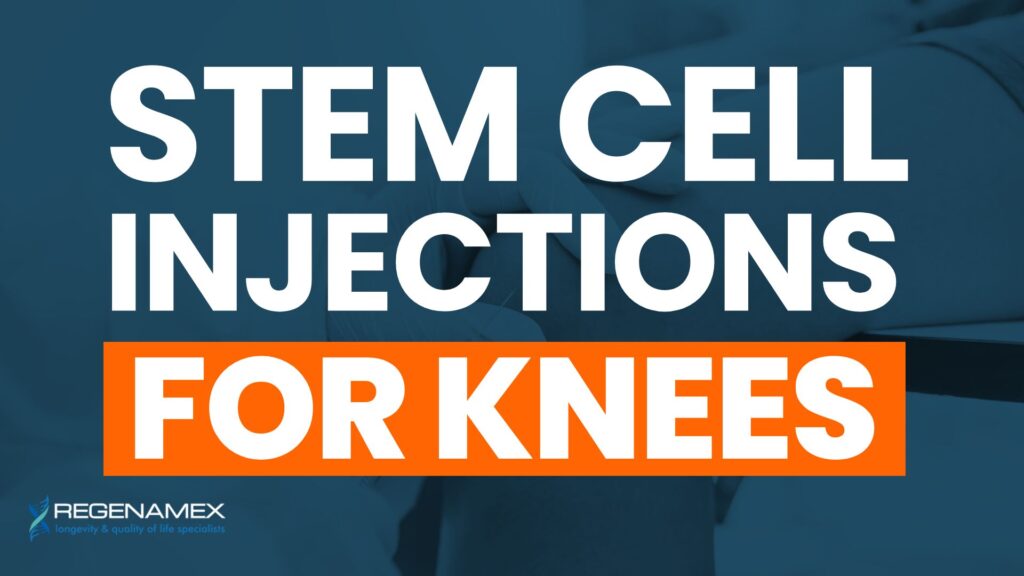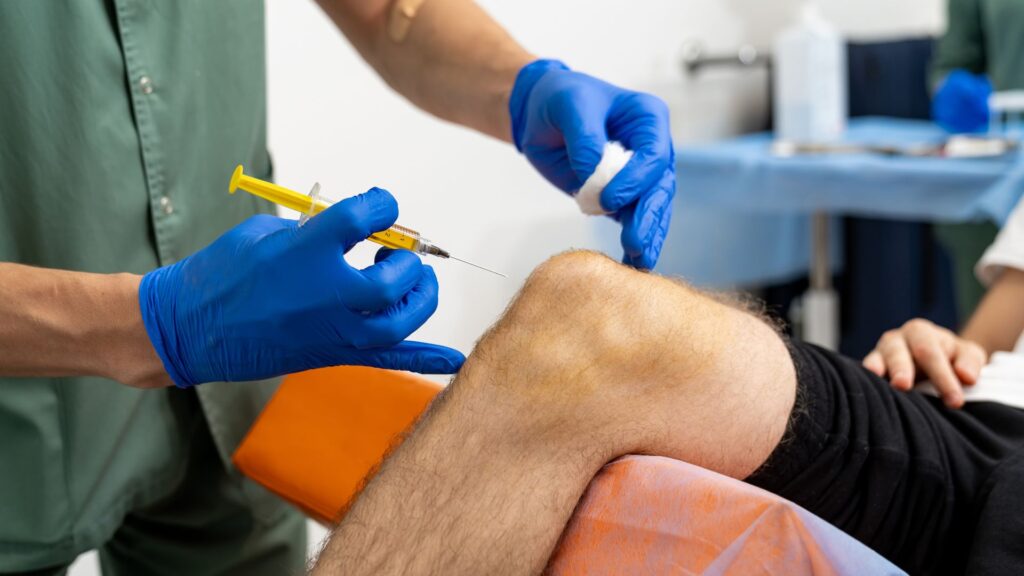
Knee Joint Stem Cell Injections
Knee joint stem cell injections are becoming one of the most promising alternatives to surgery for people living with chronic knee pain, arthritis, sports injuries, and degenerative joint disease. Instead of masking pain with medication or facing invasive procedures like joint replacement, patients now have access to regenerative treatments that actually target the root causes of inflammation and tissue damage. At Regenamex, a licensed regenerative medicine clinic in Mexico, mesenchymal stem cells (MSCs) derived from ethically donated placental tissue and Wharton’s jelly are used to restore mobility, reduce pain, and promote healing in a way that traditional treatments cannot.
By understanding how knee joint stem cell injections work, their benefits, potential risks, and how they compare to surgery, patients can make informed decisions about their care. This article explores the science, the process, and what to expect when receiving treatment at Regenamex, a clinic trusted by patients from around the world for safe, COFEPRIS-regulated regenerative therapies.
How Knee Joint Stem Cell Injections Work

Stem cells act as the body’s natural repair system, and mesenchymal stem cells (MSCs) are particularly important in treating joint issues. These specialized cells have the ability to transform into cartilage, bone, and other musculoskeletal tissues. When carefully injected into the knee, MSCs don’t just mask pain — they begin interacting with the surrounding tissues. They release signaling molecules that calm inflammation, stimulate the repair of worn cartilage, and improve lubrication in the joint. This regenerative effect helps slow or even reverse the progression of degenerative diseases like osteoarthritis, offering patients relief that goes far beyond temporary solutions.
Unlike cortisone injections or long-term reliance on painkillers, which only suppress symptoms, MSC therapy addresses the underlying damage. At Regenamex, the cells used for knee joint stem cell injections come exclusively from Wharton’s jelly and placental tissue, ensuring a high concentration of potent, ethically sourced stem cells. These are processed under strict COFEPRIS regulation, guaranteeing sterility, safety, and therapeutic effectiveness. For patients, this means that their treatment is backed by science, guided by advanced technology, and tailored to their individual condition.
Benefits of Knee Joint Stem Cell Injections
The benefits of knee joint stem cell injections are extensive, particularly for patients seeking a non-surgical path to recovery. The minimally invasive nature of the procedure allows individuals to avoid hospital stays, surgical risks, and the months of rehabilitation that often follow knee replacement surgery. Instead, patients typically return to their daily activities within days, noticing gradual improvements in mobility and pain reduction. Because the therapy works with the body’s natural regenerative systems, the results are not just about feeling better in the short term but achieving longer-lasting relief.
Beyond the physical advantages, stem cell therapy also provides peace of mind for patients who may be hesitant about invasive procedures. At Regenamex, each treatment is personalized, meaning dosages and protocols are adapted to the severity of the condition and the patient’s health history. This tailored approach ensures that patients receive the maximum benefit from the therapy. For many, the ability to walk comfortably again, return to exercise, or simply enjoy pain-free daily activities transforms their quality of life in ways they never thought possible.
Stem Cell Therapy for Arthritis

Arthritis remains one of the leading causes of disability worldwide, and the knee joint is often where symptoms are most debilitating. Traditional treatments like anti-inflammatory drugs or cortisone injections offer temporary relief but do little to address the root of the disease. Stem cell therapy for arthritis is different. By injecting MSCs directly into the affected knee, Regenamex provides a treatment that actively repairs and protects cartilage, reduces swelling, and restores function to the joint. Patients frequently report noticeable improvements within weeks, often describing less morning stiffness, more flexibility, and a return to activities that arthritis had made difficult.
For patients hoping to avoid surgery, stem cell therapy offers a vital alternative. While knee replacements can restore mobility, they also carry risks of complications, extended recovery, and eventual revision surgeries. Regenamex’s use of Wharton’s jelly-derived MSCs provides patients with an option that is not only less invasive but also highly effective at restoring natural joint function. For many, this approach adds valuable years of activity and independence, making stem cell therapy for arthritis one of the most exciting breakthroughs in modern regenerative medicine.
Stem Cell Therapy Risks
No medical treatment is completely risk-free, and understanding potential stem cell therapy risks is an important part of making an informed decision. For knee joint stem cell injections, the most common side effects are minor and short-lived, such as mild soreness, temporary swelling, or stiffness around the injection site. These typically resolve within a few days and are far less disruptive than the complications often associated with surgery. The real risks tend to come from clinics that do not follow proper safety protocols, highlighting the importance of choosing a regulated provider.
At Regenamex, risks are minimized through careful oversight, ethical sourcing, and strict COFEPRIS regulation. Every step — from harvesting and processing the cells to administering injections — is conducted under sterile conditions and guided by advanced imaging technology. Patients are fully informed about what to expect, and the clinic provides comprehensive aftercare to monitor recovery. This combination of transparency, regulation, and expertise ensures that while risks exist, they remain rare and manageable, giving patients confidence in both the safety and effectiveness of their treatment.
Stem Cell Therapy in Mexico

Stem cell therapy in Mexico has become an increasingly popular choice for international patients seeking high-quality care at affordable prices. In the United States and Canada, many regenerative therapies remain classified as experimental, leaving patients with limited access or prohibitively high costs. At Regenamex, patients find a solution that combines world-class medical expertise with transparent pricing, often at 50–70% less than what they would pay in North America. This cost-effectiveness does not come at the expense of safety or quality, as all treatments are fully regulated by COFEPRIS.
What makes Regenamex especially appealing is its holistic approach to patient care. Beyond knee joint stem cell injections, the clinic also offers complementary treatments such as platelet-rich plasma (PRP), exosomes, HGH therapy, and IV nutrition, creating an integrated healing plan. International patients benefit from the “Fly & Buy” program, which streamlines travel, treatment, and aftercare into one seamless experience. By combining affordability, strict medical oversight, and comprehensive patient support, Regenamex has positioned itself as one of the most trusted providers of stem cell therapy in Mexico.
What to Expect During Treatment at Regenamex
The treatment journey at Regenamex begins with a detailed consultation where patients share their medical history and undergo imaging or diagnostic evaluations. This step is essential to confirm candidacy and create a customized protocol tailored to the patient’s condition. Once approved, a treatment plan is designed, including the exact dosage and number of knee joint stem cell injections required. By taking a personalized approach, Regenamex ensures each patient receives the most effective care possible.
During the injection procedure, MSCs are administered using advanced imaging technology for precision placement within the joint. This accuracy maximizes the regenerative potential of the cells and reduces the risk of complications. Recovery is typically quick, with patients often resuming normal activities within days. Regenamex also emphasizes ongoing aftercare, scheduling follow-ups to monitor progress and recommend supportive therapies when needed. This structured process reassures patients that they are supported every step of the way, from initial consultation to long-term recovery.
Long-Term Outlook
Stem cell therapy is not a quick fix but a treatment that delivers steady, long-term benefits. Unlike cortisone shots, which wear off in weeks, or pain medications, which only mask symptoms, MSC therapy works to rebuild and restore joint health from within. Patients often describe continued improvements for months following treatment, with outcomes lasting years depending on the severity of their condition, lifestyle habits, and adherence to aftercare recommendations.
For many individuals, the long-term outlook means not just relief from pain but a return to independence and activity. Whether it’s walking without discomfort, climbing stairs with ease, or even resuming athletic activities, patients often regain freedoms they thought were permanently lost. In cases where surgery may eventually become necessary, knee joint stem cell injections can still provide valuable time — sometimes years — before such procedures are required. This makes the therapy not only a restorative option but also a way to extend quality of life.
FAQs: Knee Joint Stem Cell Injections
Knee joint stem cell injections are a regenerative treatment designed to target the root causes of chronic knee pain and degeneration. Instead of relying on temporary painkillers or invasive surgeries, this therapy involves carefully delivering mesenchymal stem cells (MSCs) into the knee joint. These cells are capable of reducing inflammation, repairing damaged cartilage, and improving joint lubrication, which together promote natural healing. At Regenamex, only ethically donated Wharton’s jelly and placental tissue are used, ensuring patients receive safe and effective treatments processed under strict COFEPRIS regulation.
Ideal candidates for stem cell therapy for arthritis are individuals experiencing chronic knee pain due to cartilage loss, joint degeneration, or inflammatory conditions. Patients with osteoarthritis often turn to this therapy when medications and cortisone shots no longer provide meaningful relief. Those seeking to delay or avoid knee replacement surgery also benefit greatly, as MSC injections can extend the life of the joint and restore function naturally. Regenamex evaluates each patient individually to ensure the therapy is tailored to their specific condition and overall health profile.
The safety profile of knee joint stem cell injections is one of the reasons they are rapidly gaining popularity as a non-surgical alternative. When performed at a regulated clinic like Regenamex, risks are minimal and generally limited to mild soreness, swelling, or temporary stiffness in the injected area. These side effects usually subside within days. More serious complications, such as infection, are rare and are significantly reduced when treatments follow Good Manufacturing Practice (GMP) standards and COFEPRIS oversight. This ensures that every injection meets the highest safety and quality benchmarks.
Improvements from knee joint stem cell injections often develop gradually, which reflects the natural process of regeneration rather than a quick fix. Some patients notice reduced pain and improved mobility within a few weeks, while others experience peak benefits two to three months after treatment as the stem cells continue repairing tissues and calming inflammation. Unlike cortisone shots, which wear off quickly, MSC therapy builds on itself over time, leading to more sustainable improvements in joint health and function.
Stem cell therapy has the potential to delay or even eliminate the need for knee replacement surgery in many patients. By addressing inflammation, encouraging cartilage repair, and restoring function, MSC injections can give patients years of relief without the risks associated with invasive procedures. That said, individuals with severe joint destruction may still require surgical intervention eventually. In these cases, stem cell therapy can still provide value by postponing surgery, reducing pain in the meantime, and potentially improving recovery outcomes if surgery becomes necessary.
Potential risks associated with stem cell therapy in Mexico are typically minor, including temporary swelling, mild soreness, or fatigue following treatment. The most significant risks come from choosing unregulated providers that may not follow proper protocols. Clinics like Regenamex eliminate these concerns by sourcing stem cells only from ethically donated Wharton’s jelly and placental tissue, processing them under GMP conditions, and operating under COFEPRIS regulation. This ensures that patients receive safe, high-quality care with minimal risk of complications.

